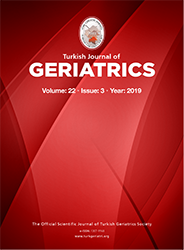2The University of Jordan, School of Medicine, Amman, Jordan DOI : 10.31086/tjgeri.2019.101 Introduction: Inappropriate prescribing in the elderly is associated with poor clinical outcomes. Using 2015 Beers criteria update, we aimed to evaluate the prevalence of inappropriate medication prescribing among elderly non-critically ill inpatients and to identify factors associated with inappropriate prescribing.
Materials and Method: This cross-sectional study included patients aged 65 years and over admitted to the internal medicine and surgical wards. Using 2015 Beers criteria, we assessed potentially inappropriate medication prescribing, both prior to admission and during the hospital stay. Binary logistic regression analysis was used to assess the predictors of PIM.
Results: Among 351 patients, the use of at least one PIM was identified in 29.3% of cases prior to admission, 98% of which continued to receive PIMs during the hospital stay. Additionally, at least one potentially inappropriate medication was identified in 47.2% of patients during the hospital stay. The most common PIMs prior to admission were proton pump inhibitors (26.2%), followed by alpha blockers (5.1%) and digoxin (4%). Proton pump inhibitors were also the most common PIMs in the hospital (42.5%), followed by alpha blockers (4.8%) and metoclopramide (4.3%).
According to the binary logistic regression analysis, factors that significantly affected PIM prescription in the hospital were the number of drugs prescribed in the hospital (odds ratio 1.222, P=0.001) and medical ward admission (odds ratio 1.686, P=0.035).
Conclusion: There is an alarmingly high prevalence of PIM use among Jordanian elderly patients, with polypharmacy being its major factor.
Keywords : Potentially inappropriate medication list; Aged; Prescription
